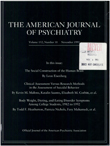Separation anxiety in panic disorder
Abstract
OBJECTIVE: A number of researchers have provided evidence that separation anxiety is an important antecedent or current affect in panic disorder. The objective of this pilot study was to test this hypothesis by comparing dreams, screen memories, and life situations of panic disorder patients with those of comparison patients. METHOD: A recent dream with associations, screen memories with associations, and life situations at onset of symptoms were recorded verbatim during semistructured interviews with 20 patients with DSM-III-R panic disorder and 20 comparison subjects upon referral to a private outpatient practice. A judge blind to the diagnoses rated each of the dreams, screen memories, and life situations separately on each of the 10 Gottschalk-Gleser Content Analysis Scales, thereby measuring manifest and latent death, mutilation, separation, guilt, and shame anxiety and overt and covert hostility in each group. RESULTS: mean separation anxiety scores were significantly higher in both the dreams and screen memories of the panic disorder patients than in the comparison patients. Mean scores for covert hostility directed outward were significantly higher in the dreams of the panic disorder patients than in the comparison patients. CONCLUSIONS: The hypothesis that separation anxiety is a prevalent affective undercurrent in the dreams and screen memories of panic disorder patients was supported. Significantly higher covert hostility in the panic disorder patients' dreams may support Bowlby's observation that people with high separation anxiety tend to disavow their anger.
Access content
To read the fulltext, please use one of the options below to sign in or purchase access.- Personal login
- Institutional Login
- Sign in via OpenAthens
- Register for access
-
Please login/register if you wish to pair your device and check access availability.
Not a subscriber?
PsychiatryOnline subscription options offer access to the DSM-5 library, books, journals, CME, and patient resources. This all-in-one virtual library provides psychiatrists and mental health professionals with key resources for diagnosis, treatment, research, and professional development.
Need more help? PsychiatryOnline Customer Service may be reached by emailing [email protected] or by calling 800-368-5777 (in the U.S.) or 703-907-7322 (outside the U.S.).



